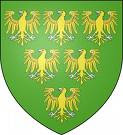My last post dealt with my visit to Leicester and the Richard III centre, as well as to Richard's tomb in the Cathedral. In the exhibition centre there was a mock-up of Richard's skeleton and the wounds inflicted upon it. In particular, there was focus on the wound at the back of Richard's head - the fatal blow that killed him. Legend has it, this blow was struck by Sir Rhys ap Thomas. He became one of Henry VII's most powerful supporters - and yet he had sworn his allegiance to King Richard and vowing that Henry Tudor would never set foot in Wales. This is the vow he allegedly made -
'
Whoever ill-affected to the state, shall dare to land in those parts of Wales where I have any employment under your majesty, must resolve with himself to make his entrance and irruption over my belly.'
Rhys ap Thomas got round this vow by hiding under Mullock Bridge, so Henry Tudor did cross into Wales over Rhys' belly! Rhys quickly joined Henry Tudor's army and marched with him to Bosworth. The story that Rhys slew Richard is written about by the poet Guto’r Glyn (1412-1493), referring to King Richard’s emblem of a boar
, wrote contemporaneously that Rhys “killed the boar, shaved his head”. Richard's skull was indeed shaved. Rhys was knighted on the battlefield and went on to serve Henry VII loyally, becoming a knight of the Garter in 1505 and becoming a privy councillor. He celebrated with a grand tournament at Carew Castle. Here are some photos from my last visit.
You can read more about Rhys ap Thomas in Susan Fern's book 'The Man Who Killed Richard III'.










